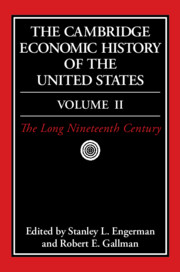Book contents
- Frontmatter
- 1 Economic Growth and Structural Change in the Long Nineteenth Century
- 2 The Economy of Canada in the Nineteenth Century
- 3 Inequality in the Nineteenth Century
- 4 The Population of the United States, 1790–1920
- 5 The Labor Force in the Nineteenth Century
- 6 The Farm, The Farmer, and The Market
- 7 Northern Agriculture and the Westward Movement
- 8 Slavery and its Consequences for the South in the Nineteenth Century
- 9 Technology and Industrialization, 1790–1914
- 10 Entrepreneurship, Business Organization, and Economic Concentration
- 11 Business Law and American Economic History
- 12 Experimental Federalism: the Economics of American Government, 1789–1914
- 13 Internal Transportation in the Nineteenth and Early Twentieth Centuries
- 14 Banking and Finance, 1789–1914
- 15 U.S. Foreign Trade and the Balance of Payments, 1800–1913
- 16 International Capital Movements, Domestic Capital Markets, and American Economic Growth, 1820–1914
- 17 The Social Implications of U.S. Economic Development
- Bibliographic Essays
- Index
- References
1 - Economic Growth and Structural Change in the Long Nineteenth Century
Published online by Cambridge University Press: 28 March 2008
- Frontmatter
- 1 Economic Growth and Structural Change in the Long Nineteenth Century
- 2 The Economy of Canada in the Nineteenth Century
- 3 Inequality in the Nineteenth Century
- 4 The Population of the United States, 1790–1920
- 5 The Labor Force in the Nineteenth Century
- 6 The Farm, The Farmer, and The Market
- 7 Northern Agriculture and the Westward Movement
- 8 Slavery and its Consequences for the South in the Nineteenth Century
- 9 Technology and Industrialization, 1790–1914
- 10 Entrepreneurship, Business Organization, and Economic Concentration
- 11 Business Law and American Economic History
- 12 Experimental Federalism: the Economics of American Government, 1789–1914
- 13 Internal Transportation in the Nineteenth and Early Twentieth Centuries
- 14 Banking and Finance, 1789–1914
- 15 U.S. Foreign Trade and the Balance of Payments, 1800–1913
- 16 International Capital Movements, Domestic Capital Markets, and American Economic Growth, 1820–1914
- 17 The Social Implications of U.S. Economic Development
- Bibliographic Essays
- Index
- References
Summary
INTRODUCTION
This chapter is concerned with quantitative features of the development of the American economy in the period between the late eighteenth century and World War I – the long nineteenth century. A reasonable place to begin is with measurements of the size of the economy. Since a central feature of any economy is production, size is appropriately measured by aggregate output. Other indicators, such as population and geographic extent, are considered below.
The conventional measures of aggregate output are the national product – that is, output produced by factors of production owned by Americans – and the domestic product – output produced by factors of production domiciled in the United States. The proper index to select depends upon whether one thinks of the United States as the sum of all Americans or as a geographic entity. We are interested in the history of the people of the United States, and therefore the national product is the more appropriate concept. It underlies most of the measurements treated in this chapter; in practice the choice matters little, however, since in the years under examination the national product and the domestic product were virtually identical. A more important question is the extent to which these conventional measures properly describe levels of output and changes in output over time, a question set aside for the moment but treated later in this essay.
- Type
- Chapter
- Information
- The Cambridge Economic History of the United States , pp. 1 - 56Publisher: Cambridge University PressPrint publication year: 2000
References
- 15
- Cited by



